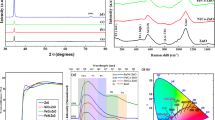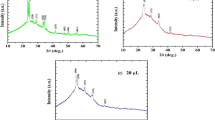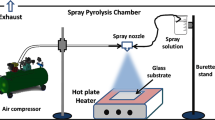Abstract
ZnO films with varying fluorine content were prepared on Corning glass by radio frequency magnetron sputtering of ZnO target containing ZnF2 at room temperature, and the compositional, electrical, optical, and structural properties of the as-grown films together with the vacuum-annealed films were investigated. The fluorine content in the fluorine doped ZnO (FZO) films increased almost linearly with increasing ZnF2 content in sputter target, and the highest atomic concentration was 7.3%. Vacuum-annealing caused a slight reduction of fluorine content in the films. The resistivity of the as-grown FZO films deposited showed a typical valley-like behavior with respect to the fluorine content in film, i.e. having minimum resistivity at intermediate fluorine content. Despite high fluorine content in the FZO films, the carrier concentration remained below 1.2 × 1020 cm−3, leading to very low doping efficiency level. Upon vacuum-annealing, the resistivity of FZO films decreased substantially due to increase in both the carrier concentration and the Hall mobility. From the structural analysis made by X-ray diffraction study, it was shown that addition of small amount of fluorine enhanced the crystallinity of FZO films with (002) preferred orientation, and that large amount of fluorine addition yielded disruption of preferred orientation. It was also shown that doping of fluorine rendered a beneficial effect in reducing the absorption loss of ZnO films in visible range, thereby substantially enhancing the figure of merit.






Similar content being viewed by others
References
J. F. Carlin Jr., U.S. Geological Survey, Mineral Commodity Summaries, Jan. (2006)
K. Ellmer, J. Phys. D: Appl. Phys. 34, 3097 (2001). DOI 10.1088/0022-3727/34/21/301
T. Minami, MRS Bull. 25(8), 38 (2000)
J. Kr, M. Zeman, O. Kluth, F. Smole, M. Topi, Thin Solid Films 426, 296 (2003). DOI 10.1016/S0040-6090(03)00006-3
R. Groenen, J.L. Linden, H.R.M. van Lierop, D.C. Schram, A.D. Kuypers, M.C.M. van de Sanden, Appl. Surf. Sci. 173, 40 (2001). DOI 10.1016/S0169-4332(00)00875-8
S.-M. Park, T. Ikegami, K. Ebihara, Thin Solid Films 513, 90 (2006). DOI 10.1016/j.tsf.2006.01.051
S. Kishimoto, T. Yamada, K. Ikeda, H. Makino, T. Yamamoto, Surf. Coat. Technol. 201, 4000 (2006). DOI 10.1016/j.surfcoat.2006.08.009
J. Hu, R.G. Gordon, Solar Cells 30, 437 (1991). DOI 10.1016/0379-6787(91)90076-2
M. de la L. Olivera, A. Maldonado, R. Asomoza, O. Solorza, D.R. Acosta, Thin Solid Films 394, 242 (2001)
M. de la L. Olivera, A. Maldonado, R. Asomoza, Solar Energy Mat. Solar Cell 73, 425 (2002). DOI 10.1016/S0927-0248(02)00211-8
T. Miyata, S. Ida, T. Minami, J. Vac. Sci. Technol. A 21(4), 1404 (2003). DOI 10.1116/1.1580492
T. Minami, S. Ida, T. Miyata, Y. Minamoto, Thin Solid Films 445, 268 (2003). DOI 10.1016/S0040-6090(03)01159-3
H.Y. Xu, Y.C. Liu, R. Mu, C.L. Shao, Y.M. Lu, D.Z. Shen, X.W. Fan, Appl. Phys. Lett. 86, 123107–1 (2005). DOI 10.1063/1.1884256
R.G. Gordon, MRS Bull. 25(8), 52 (2000)
R.C. Weast, M.J. Astle, Handbook of Chemistry and Physics, 61th edn. (CRC, Boca Raton, 1980–1981), pp. B-164
Y. Shigesato, N. Shin, M. Kamei, P.K. Song, I. Yasui, Jpn. J. Appl. Phys. 29, 6422 (2000). DOI 10.1143/JJAP.39.6422
K.S. Lee, T.S. Lee, I.H. Kim, B. Cheong, W.M. Kim, Integr Ferroelectr 69, 295 (2005). DOI 10.1080/10584580590899045
B. Stjerna, E. Olsson, C.G. Granqvist, J. Appl. Phys. 76, 3797 (1994). DOI 10.1063/1.357383
R. Cebulla, W. Wendt, K. Ellmer, J. Appl. Phys. 83, 1087 (1998). DOI 10.1063/1.366798
A. Sanchez-Juareza, A. Tiburcio-Silverb, A. Ortizc, E.P. Zironid, J. Rickards, Thin Solid Films 333, 196 (1998). DOI 10.1016/S0040-6090(98)00851-7
A.F. Kohan, G. Ceder, D. Morgan, C.G. Van de Walle, Phys. Rev. B 61, 15019 (2000). DOI 10.1103/PhysRevB.61.15019
K. Ellmer, J. Phys. D: Appl. Phys. 33, R17 (2000). DOI 10.1088/0022-3727/33/4/201
L.E. Brus, J. Chem. Phys. 80, 4403 (1984). DOI 10.1063/1.447218
T. Senda, Y.-J. Cho, T. Hirakawa, H. Okamoto, H. Takakura, Y. Hamakawa, Jpn. J. Appl. Phys. 39, 4716 (2000). DOI 10.1143/JJAP.39.4716
S.A. Knickerbocker, A.K. Kulkarni, J. Vac. Sci. Technol. A, 13, 1048 (1995). DOI 10.1116/1.579583
Acknowledgements
This study was partially supported by a grant from the Fundamental R&D Program for Core Technology of Materials funded by the Ministry of Commerce, Industry and Energy, Republic of Korea.
Author information
Authors and Affiliations
Corresponding author
Rights and permissions
About this article
Cite this article
Ku, D.Y., Kim, Y.H., Lee, K.S. et al. Effect of fluorine doping on the properties of ZnO films deposited by radio frequency magnetron sputtering. J Electroceram 23, 415–421 (2009). https://doi.org/10.1007/s10832-008-9480-8
Received:
Accepted:
Published:
Issue Date:
DOI: https://doi.org/10.1007/s10832-008-9480-8




